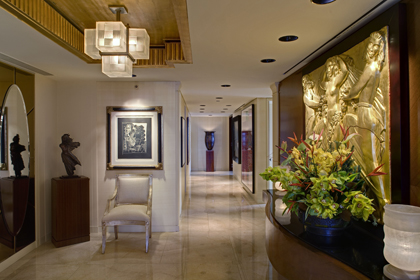
Welcome to the debut of We Hear You!  As a successful, interior designer who has been in the industry for more than three decades, many of my clients, friends and colleagues have encouraged me to write a book and share my knowledge and musings about interior design.  While I’m not quite ready to embrace an entire book, I am ready to write a blog.
Furthermore, through the years my clients have told me over and over again that not only do I listen to them but I actually hear what they have to say.  I hear their dreams, their worries and their ideas and ultimately guide them to what they really want.  I think this is one of the main reasons I excel in my career –I believe I’m a talented interior designer, of course, but I really do hear my clients.  This is why we say at Cannon Frank “We Hear You†and thus, the name of my blog.
There are many interior design blogs and I hope this one offers a unique perspective: actually two of them!  With each blog entry about a particular design-related topic, I will write from the designer’s viewpoint and also from the client’s viewpoint.  Why write for both?  Well, my goal is that a designer reading a client’s viewpoint and a client reading a designer’s viewpoint will help both parties understand each other better and help build a successful relationship…with the end result being a gorgeous project.
Through many years of business and relationships with other designers, I have learned that whenever you get more than a few designers in one room, add a few cocktails and the stories begin to “fly.† Usually they are the same…only the names and a few details change, but it has always struck me as odd…the relationship between what the client says and what the designer hears…the same can be said of the opposite.  Follow the blog to see if I can represent both viewpoints.
For the Designer
When a client says they want to get the most out of their project, you first need to understand what they are asking for.  Do they want you to work for low fees, do they want a lot for the budget they have or are they looking for the maximum impact they can achieve….hopefully the latter, but this is the first rule in a good client/designer relationship — clear and concise understanding of what they want and what you can provide.  Don’t be afraid to discuss the ugly topic of compensation.  You need to be paid for what you are giving and if they want to negotiate your fees, determine if you can, but don’t give yourself away and become enslaved to a project.
Clients usually don’t know how much work is required for their project…don’t be afraid to let them know what you are doing and why it needs to be done and always keep them informed of any issue which may come up with your suppliers…you don’t want to pass on to them any false information you get from a vendor, but as we all know, sometimes vendors tell you what you want to hear rather than the truth.  You also need to let your vendors know how to work with you…you won’t tolerate lies…it makes you a liar to your client, so teach your clients and teach your vendors how you expect them to work with you.
For the Client
When you decide to work with a designer, be concise with your information and if you don’t know what to tell them, try to formulate at least what style you would prefer even if it means cutting out magazine articles with something you like as a reference.  Try to figure out what you can spend and always tell the designer what you expect them to provide to you in terms of drawings, services, samples, concepts and what he or she is to include in their presentation.  Also, please remember your designer is only the designer…he/she does not make these pieces, ship the pieces nor is he/she the one who will take these pieces back if you decide you don’t like them, and all shipping dates come from the manufacturer, so if the piece is late, your designer most likely had nothing to do with that as well…. Also if you come to an agreement with your designer, keep the terms of your agreement with that designer because the first thing a designer won’t do is work for free when you decide to hold back on your payments. Since you are in control of your checkbook, if the designer shows you a piece which is over the budget, you need to decide how this affects your overall budget…can it stretch or does Peter need to pay Paul?
For the Designer and Client
Giving a client what they want is always very important, but don’t give them something you don’t believe in…if she wants Lucite chairs on castors at her dining table, you may have to discuss other options or tell her to go shopping for herself …that you just won’t be a party to bad taste!  If you discuss certain concepts with a client, don’t be worried about telling them how you really feel about some of their ideas and adapt to give them what they want albeit within the realm of good taste.
Having a designer do what you want is all well and good, but remember, you hired a professional to give you his or her opinion. If you choose not to listen to your designer, don’t be surprised if they lose interest if this is outside their realm of a great concept.
I will be posting more information and discussions on Client/Designer relationships on We Hear You in the near future.